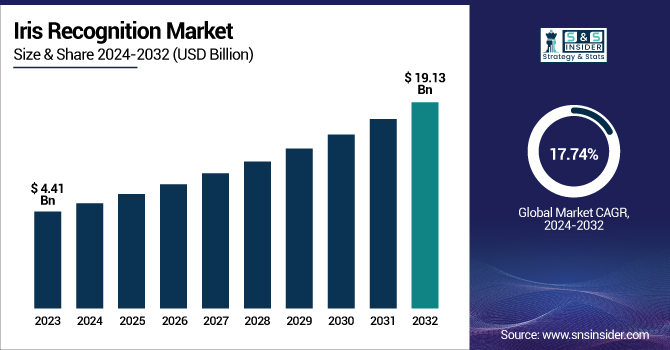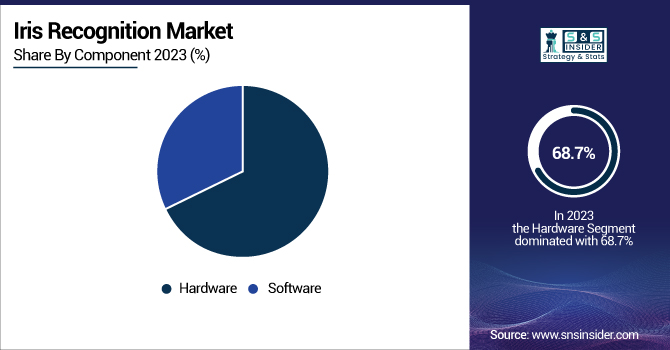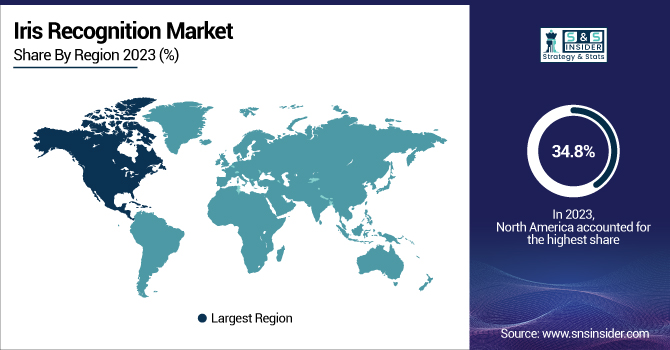Iris Recognition Market Size & Trends:
The Iris Recognition Market Size was valued at USD 4.41 Billion in 2023 and is expected to reach USD 19.13 Billion by 2032 and grow at a CAGR of 17.74% over the forecast period 2024-2032.

To Get more information on Iris Recognition Market - Request Free Sample Report
The iris recognition market is being developed as sensor technology is changing and it is helping in the fast and accurate method of identification using iris recognition thus enhancing the secured method of identification. Recent trends in the manufacture of biometric sensors revolve around miniaturization and great efficiency for smooth integration into varied applications. Improvements in sensor technology lead to more precise and versatile across environments.
The use of iris recognition in IoT and smart city infrastructures further strengthens security by enabling contactless access control, surveillance, and digital ID in urban and connected environments. The U.S. iris recognition market was used in many applications in different sectors in 2024. Iris recognition was used by government agencies for access control and identity authentication. This technology was adopted in the banking and finance industry as a way to improve customer authentication and reduce fraud. Healthcare institutions employed iris recognition to be free from the want of securing patient relate and managing entry to confined areas.
The U.S. Iris Recognition Market is estimated to be USD 1.21 Billion in 2023 and is projected to grow at a CAGR of 17.52%. Growing concerns about the threat of cyberattacks, increasing implementations in border control and airport security, and a shift to contactless authentication in the post-pandemic era are likely to drive the iris recognition market in the U.S. Also, the rise in legislative enforcement for biometric security, growing intelligence surveillance implementations, and organization-level requirements for secure workforce authentication drive the growth of the market.
Iris Recognition Market Dynamics
Key Drivers:
-
Advancing Iris Recognition Technology Driving Secure Authentication Across Government Finance Healthcare and Consumer Devices
The iris recognition market is growing rapidly in response to increased demand for secure and seamless login across a variety of industries. Government initiatives for national ID programs, e-passports, and border security have been instrumental in this growth with several countries offering iris-based biometric systems for identity verification. Iris recognition is being incorporated into the banking and financial sector for secure transactions and the reduction of fraud, which is further boosting the growth of the market. Moreover, the growing adoption of biometric authentication technology in other consumer devices including smartphones and wearables, coupled with the growing need to improve efficiency and functionality is estimated to fuel the growth of the biometric system market over the forecast period. Rapid developments in artificial intelligence (AI) and machine learning are increasing the accuracy of iris recognition, decreasing the likelihood of false positives and false negatives, and widening applications in healthcare, enterprise access control, and defense.
Restrain:
-
Overcoming Privacy Security Standardization and Environmental Challenges in Advancing Iris Recognition Technology Adoption
Privacy and Data Security Challenge is a big challenge since biometric information itself is very sensitive. Users will also be reluctant to adopt iris scanners if there is a significant risk of a leak or unauthorized access to stored iris information, the data being at high risk of being hacked, potentially risking lives and starting a regulatory nightmare. Moreover, standardization in biometric authentication systems is another challenge as a variety of frameworks with the use of different technologies are employed by different industries and governments around the world making it nearly impossible for the systems to become seamlessly integrated and to be interoperable. Also, some environmental factors like low light, and mirrors, as well as, eyeglasses and contact lenses, may result in false declines and impact the end-user experience, affecting iris recognition performance.
Opportunity:
-
Expanding Opportunities in Iris Recognition for Biometric Payments Automotive Security and Contactless Authentication Solutions
Rising adoption of biometric payment solutions is one of the opportunities in the iris recognition market, where financial institutions as well as fintech companies are adopting iris recognition for secured mobile transactions. The automotive sector is another promising vertical, as biometric-based driver identification improves vehicle security. Furthermore, an increasing interest in contactless biometrics accelerated by the pandemic opens new opportunities for growth in healthcare, travel, and smart city use cases. The combination of iris recognition an effective multi-factor authentication technology-with AI, blockchain, and cloud-based security solutions would present a great market opportunity as demand for MFA technology is growing.
Challenges:
-
Building Trust Overcoming Scalability and Enhancing AI for Future Growth in Iris Recognition Technology
End-users are one of the most considerable challenges in our industry, where acceptance and trust in biometric technology are paramount. While the technology is safe, some shy away from iris recognition, fearing invasive methods of scanning or harmful effects. In large-scale deployments like national ID programs or airport security, the high computational power and infrastructural base needed to manage vast biometric databases lead to scalability problems. With the ongoing evolution of the technology, overcoming these challenges by achieving more efficient AI-based image analytics, by better-designed set of hardware and improved methods for the protection of data between devices and the cloud will be needed for the growth of the market.
Iris Recognition Industry Segmentation Analysis
By Component
The iris recognition market was dominated by hardware, which accounted for 68.7% of the overall share during 2023. This dominance was driven largely by the widespread adoption of iris scanners, biometric cameras, and infrared sensors throughout the security, government, and defense industries. This surge in the need for sound and high-performance hardware solutions was further exacerbated by the ever-growing usage of biometric authentication systems in border control, banking, and enterprise security. Moreover, the market dominance of the hardware segment was also cemented, driven by the innovation in sensor technology and integration of embedded biometrics into consumer electronics, technologies such as smartphones, and wearables.
Software is anticipated to witness the highest compound annual growth rate (CAGR) from 2024 to 2032 as the integration of AI-based recognition algorithms for better accuracy and increased demand for cloud-based biometric authentication propels its growth. The increasing use of software-based biometrics in mobile banking, digital payments, and enterprise security coupled with the need for scalable and cost-effective biometric solutions are driving the adoption of software biometrics. With continuous efforts in improving iris recognition accuracy and speed of deep learning and edge AI, software-based biometric solutions will garner traction among industries.

By Product
Scanners held 34.3% of the total share of the iris recognition market in 2023. This dominance was driven by their mass adoption across government, defense, and border security applications, with high-precision iris scanners being essential to national ID programs, law enforcement, and immigration control. Furthermore, sectors like healthcare and enterprise security depended on standalone scanning devices for precise biometric authentication and secure entry/access control. Scanners led the market due to the constant requirement for high-performance, standalone biometric devices in critical infrastructure.
From 2024 to 2032, the fastest CAGR over the forecast period is expected to be recorded by smartphones, driven by the increasing adoption of iris recognition for mobile authentication and digital payments. But as the demand for password-less security combined with the development of AI-driven facial and iris scanning, smartphones will be a significant biometrics adoption sector. The popularity of on-device biometric authentication will fuel strong growth in this segment as mobile banking, fintech, and consumer electronics grow.
By Application
The iris recognition market was dominated by Identity Management and Access Control, which accounted for 57.3% of the iris recognition market in 2023. This dominance was propelled by the increasing use of biometric authentication across government agencies, corporate security, defense, and border control. For high-security applications like airports, national ID programs, and enterprise access systems, iris recognition is the solution of choice owing to its superior accuracy and fraud resistance. The increasing focus on contactless authentication during and after the pandemic also led to increased applications of iris-based access control solutions across the healthcare and critical infrastructure vertical.
E-payment is projected to grow at the fastest CAGR between 2024 and 2032 due to the increasing need for safer and frictionless transactions. As financial institutions and fintech providers follow suit adopting biometric authentication for mobile banking and digital wallets, iris recognition is becoming a secure two-factor option for passwords and PINs. The increasing trend of a cashless economy, along with the rapid onset of AI-assisted fraud detection technologies will only act as a catalyst in its adoption within the payment landscape.
By Vertical
In 2023, the government sector led the iris recognition market with a 39.6% share of the total share. Such dominance was propelled via expanding biometrics-based national ID programs, e-passports, border management, and law enforcement applications. Iris Recognition technology has been integrated with several systems to improve citizen identification, immigration security, and voter registration systems by numerous governments around the world. The increasing focus on contactless biometric identification in public sector services also sweetened the pot for its adoption.
Banking & Finance is projected to be the fastest-growing CAGR during 2024-2032, driven by increasing demand for secure and fraud-resistant digital transactions. As economies around the world are rapidly moving towards cashless societies, and financial authentication is largely being based on biometric identifiers, banks, and fintech are adopting iris recognition for mobile banking, ATMs, and digital payment systems. As fraud detection driven by AI along with multi-factor authentication become industry norms, iris biometrics will be one of the tools to support transaction security while providing an unparalleled experience for traders and users alike.
Iris Recognition Market Regional Outlook
North America accounted for 34.8% of the iris recognition market in 2023, owing to the high adoption of biometric security systems across various sectors, including government, defense, banking, and consumer electronics. As a result, iris recognition has been incorporated into one of its border patrol programs for the U.S. Customs and Border Protection, the so-called Biometric Entry-Exit System aims to strengthen immigration controls and national security. For example, Wells Fargo and most top banks use biometric authentication for secure banking transactions in the financial sector. As evidenced by big tech including the likes of Apple and Microsoft investing in high-tech biometric security including iris recognition for future devices.
Asia Pacific will witness the fastest CAGR growth from 2024 to 2032, and this is due to the increasing adoption of government initiatives, mobile banking, and consumer electronics in the region. One of the largest biometric databases in the world, India now effectively uses iris recognition as a means to authenticate citizens and distribute subsidies. The Chinese government has been using biometric authentication in smart city projects and surveillance systems, and large smartphone manufacturers like Samsung included iris recognition in some flagship devices. Asia Pacific is poised to drive the next wave of iris recognition as financial services become rapidly digitized in the region, and investment in AI-enabled biometrics rises.

Get Customized Report as per Your Business Requirement - Enquiry Now
Key Players Listed in Iris Recognition Market are:
Some of the major players in the Iris Recognition Market are:
-
IriTech, Inc. (IriShield Binocular BK2121)
-
IrisGuard Ltd. (EyePay® Network)
-
NEC Corporation (NEC Iris Recognition Technology)
-
Iris ID, Inc. (iCAM TD100)
-
Thales Group (Gemalto Cogent Iris Scanner CIS202)
-
IDEMIA (MorphoWave Compact)
-
HID Global (iCLASS SE® RB25F)
-
EyeLock LLC (EyeLock Nano NXT)
-
Princeton Identity Inc. (IOM Access200)
-
CMITech Company, Ltd. (EF-45N Dual Iris Recognition System)
-
Aware, Inc. (KnockKnock)
-
BioEnable Technologies Pvt. Ltd. (BioEnable Iris Scanner)
-
Diebold Nixdorf (Iris-enabled ATMs)
-
Recogtech B.V. (IrisOne)
-
SRI International (IOM PassPort)
Recent Trends
-
In March 2025, IriTech present its latest iris recognition solutions at MOSIP Connect 2025, highlighting innovations in secure digital identity, financial inclusion, and border security through advanced biometric technology.
-
In March 2024, Princeton Identity launches a next-gen edge biometric scanner with iris, face, and fingerprint recognition, enhancing secure authentication across key industries.
| Report Attributes | Details |
|---|---|
| Market Size in 2023 | USD 4.41 Billion |
| Market Size by 2032 | USD 19.13 Billion |
| CAGR | CAGR of 17.74% From 2024 to 2032 |
| Base Year | 2023 |
| Forecast Period | 2024-2032 |
| Historical Data | 2020-2022 |
| Report Scope & Coverage | Market Size, Segments Analysis, Competitive Landscape, Regional Analysis, DROC & SWOT Analysis, Forecast Outlook |
| Key Segments | • By Component (Hardware, Software) • By Product (Smartphones, Wearables, Tablets & Notebooks, Personal Computers/Laptops, Scanners) • By Application (Identity Management and Access Control, Time Monitoring, E-Payment) • By Vertical (Military & Defense, Banking & Finance, Travel & Immigration, Government, Healthcare, Consumer Electronics, Automotive) |
| Regional Analysis/Coverage | North America (US, Canada, Mexico), Europe (Eastern Europe [Poland, Romania, Hungary, Turkey, Rest of Eastern Europe] Western Europe] Germany, France, UK, Italy, Spain, Netherlands, Switzerland, Austria, Rest of Western Europe]), Asia Pacific (China, India, Japan, South Korea, Vietnam, Singapore, Australia, Rest of Asia Pacific), Middle East & Africa (Middle East [UAE, Egypt, Saudi Arabia, Qatar, Rest of Middle East], Africa [Nigeria, South Africa, Rest of Africa], Latin America (Brazil, Argentina, Colombia, Rest of Latin America) |
| Company Profiles | IriTech, IrisGuard, NEC Corporation, Iris ID, Thales Group, IDEMIA, HID Global, EyeLock, Princeton Identity, CMITech, Aware, BioEnable Technologies, Diebold Nixdorf, Recogtech, SRI International. |

